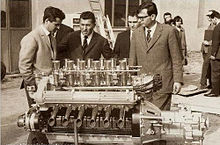Portal:Cars
The Cars PortalA car, or an automobile, is a motor vehicle with wheels. Most definitions of cars state that they run primarily on roads, seat one to eight people, have four wheels, and mainly transport people over cargo. There are around one billion cars in use worldwide. The car is considered an important part of the developed economy. The French inventor Nicolas-Joseph Cugnot built the first steam-powered road vehicle in 1769, while the Swiss inventor François Isaac de Rivaz designed and constructed the first internal combustion-powered automobile in 1808. The modern car—a practical, marketable automobile for everyday use—was invented in 1886, when the German inventor Carl Benz patented his Benz Patent-Motorwagen. Commercial cars became widely available during the 20th century. The 1901 Oldsmobile Curved Dash and the 1908 Ford Model T, both American cars, are widely considered the first mass-produced and mass-affordable cars, respectively. Cars were rapidly adopted in the US, where they replaced horse-drawn carriages. In Europe and other parts of the world, demand for automobiles did not increase until after World War II. In the 21st century, car usage is still increasing rapidly, especially in China, India, and other newly industrialised countries. Cars have controls for driving, parking, passenger comfort, and a variety of lamps. Over the decades, additional features and controls have been added to vehicles, making them progressively more complex. These include rear-reversing cameras, air conditioning, navigation systems, and in-car entertainment. Most cars in use in the early 2020s are propelled by an internal combustion engine, fueled by the combustion of fossil fuels. Electric cars, which were invented early in the history of the car, became commercially available in the 2000s and are predicted to cost less to buy than petrol-driven cars before 2025. The transition from fossil fuel-powered cars to electric cars features prominently in most climate change mitigation scenarios, such as Project Drawdown's 100 actionable solutions for climate change. (Full article...) Entries here consist of Good and Featured articles, which meet a core set of high editorial standards.
The Chrysler Turbine Car is an experimental two-door hardtop coupe powered by a turbine engine and was manufactured by Chrysler from 1963 to 1964. Italian design studio Carrozzeria Ghia constructed the bodywork, and Chrysler completed the final assembly in Detroit. A total of 55 cars were manufactured: five prototypes and a limited run of fifty cars for a public user program. All have a signature metallic paint named "turbine bronze", roughly the color of root beer. The car was styled by Elwood Engel and Chrysler studios. They featured power brakes, power steering, and a TorqueFlite transmission. The Chrysler turbine engine program that produced the Turbine Car began during the late 1930s and created prototypes that completed long-distance trips in the 1950s and early 1960s. The A-831 engines that powered the Ghia-designed Turbine Car could operate on many fuels, required less maintenance, and lasted longer than conventional piston engines. However, they were much more expensive to produce. (Full article...) Selected article -The Lamborghini V12 refers to the flagship V12 engine used by Lamborghini. Lamborghini has had two generations of V12 engines through their history, both of which were developed in-house. The first-generation Lamborghini V12 was a sixty degree (60°) V12 petrol engine designed by Lamborghini, and was the first internal combustion engine ever produced by the firm. It entered production in 1963 as a 3.5 litre displacing 3,465 cubic centimetres (211.4 cu in) fitted on Lamborghini's first car, the Lamborghini 350GT. The engine remained in use for almost fifty years; the final version of 6.5 litre displacement was installed in the Lamborghini Murciélago. Lamborghini discontinued their first-generation V12 after the Murcielago, opting for a brand-new V12 that first saw use on the Lamborghini Aventador. (Full article...)Selected picture of the day
Selected biography -Kiichiro Toyoda (Japanese: 豊田 喜一郎, Hepburn: Toyoda Kiichirō, June 11, 1894 – March 27, 1952) was a Japanese businessman and the son of Toyoda Loom Works founder Sakichi Toyoda. His decision to change Toyoda's focus from automatic loom manufacture into automobile manufacturing created what later became Toyota Motor Corporation. (Full article...) On this day November 24Did you know...
Selected quote of the dayIf you can find a better car, buy it! —Lee Iacocca's pitch to buyers of the K-car line that saved Chrysler Corporation from insolvency in the 1980s TopicsGeneral imagesThe following are images from various car-related articles on Wikipedia.
CategoriesThings you can do to help If you wish to help, you can:
Associated WikimediaThe following Wikimedia Foundation sister projects provide more on this subject:
Discover Wikipedia using portals |












































































